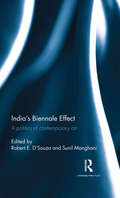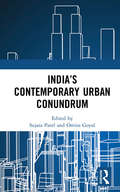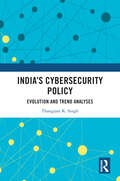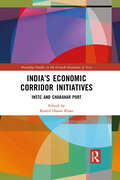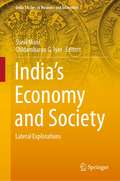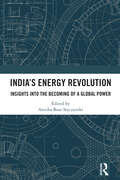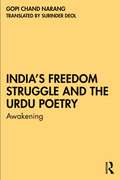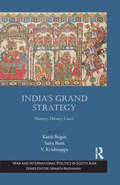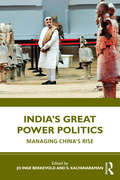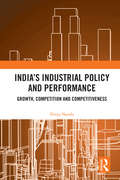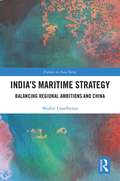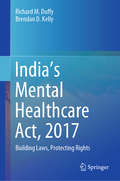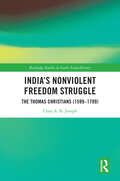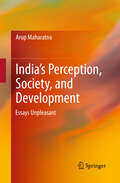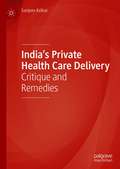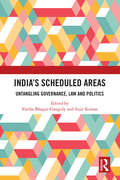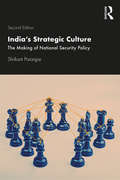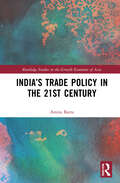- Table View
- List View
India’s Biennale Effect: A politics of contemporary art
by Sunil Manghani Robert E. D'SouzaIndia’s Kochi-Muziris Biennale has been described as one of the most significant newly emergent biennales, alongside Shanghai, Sharjah and Dakar. However, there have been few sustained and critical studies of these events as specific sites of production and reception of contemporary art. This book, engaging with the Kochi Biennale, provides detailed examination of what the editors term as the ‘biennale effect’ — a layered contestation of place, economics, art and politics. It presents a close reading of the unique context of the biennale as well as sets out a broader critical framework for understanding global contemporary art and its effects. Replete with illustrations, this book will serve as an important and rare resource for scholars and researchers of contemporary art, art history, visual cultures, and media studies.
India’s Contemporary Urban Conundrum
by Sujata Patel Omita GoyalThis book lays out the different and complex dimensions of urbanisation in India. It brings together contributors with expertise in fields as varied as demography, geography, economics, political science, sociology, anthropology, architecture, planning and land use, environmental sciences, creative writing, filmmaking and grassroots activism to reflect on and examine India’s urban experience. It discusses various dimensions of city life—how to define the urban; the conditions generating work, living and (in)security; the nature of contemporary cities; the dilemmas of creating and executing urban policy, planning and governance; and the issues concerning ecology and environment. The volume also articulates and evaluates the way Indian urbanism promotes and organises aspirations and utopias of the people, whilst simultaneously endorsing disparities, depravities and conflicts. The volume includes interventions that shape contemporary debates. Comprehensive, accessible and topical, it will be useful to scholars and researchers of urban studies, urban sociology, development studies, public policy, economics, political studies, gender studies, city studies, planning and governance. It will also interest practitioners, think tanks and NGOs working on urban issues.
India’s Cybersecurity Policy: Evolution and Trend Analyses
by Thangjam K. SinghThis book examines India’s public policies on cybersecurity and their evolution over the past few decades. It shows how threats and vulnerabilities in the domain have forced nation-states to introduce new policies to protect digital ecosystems. It charts the process of securitisation of cyberspace by the international system from the end of the 20th century to the present day. It also explores how the domain has become of strategic interest for many states and the international bodies which eventually developed norms and policies to secure the domain.Consequently, the book discusses the evolution of cybersecurity policy at global level by great powers, middle powers, and states of concern and compares them with the Indian context. It also highlights the requirement of introducing/improving new cybersecurity guidelines to efficiently deal with emerging technologies such as 5G, Artificial Intelligence (AI), Big Data (BD), Blockchain, Internet of Things (IoT), and cryptocurrency.The book will be of great interest to scholars and researchers of cybersecurity, public policy, politics, and South Asian studies.
India’s Economic Corridor Initiatives: INSTC and Chabahar Port (Routledge Studies in the Growth Economies of Asia)
by Kashif Hasan KhanIndia’s Economic Corridor Initiatives highlights key aspects of current discourses on India’s initiative of the International North-South Transport Corridor (INSTC) and Chabahar, and their geo-economic significance.INSTC was founded by India, Russia, and Iran, and the Chabahar port in Iran provides a major prospective conduit for India's interchange and commerce with West Central Asia while maintaining a strategic distance from Pakistan's entry route. This book analyses the drastic changes in the equation of international relations in general, and more particularly between India and Eurasian countries. Contributors from Iran, Central Asia, Russia, Armenia and Europe provide a wide spectrum of opinion and analysis on the subject. The chapters claim that these corridors provide an alternative to the BRI and can play a pivotal role in de-escalating tensions through negotiations.A new addition to the debate on contemporary dynamics in Eurasia and India, this book will be of interest to researchers studying economic corridors, transnational and trans-regional economic relationships, security studies, regional and area studies, international relations and Indo-Iran-Russia relations.
India’s Economy and Society: Lateral Explorations (India Studies in Business and Economics)
by Sunil Mani Chidambaran G. IyerThis book is a collection of fifteen contributions that undertake a detailed analysis of seven broad dimensions of India’s economy and society. All the contributions approach the problems in their respective areas empirically, while being theoretically informed. The book begins with a section containing detailed and empirically supported chapters on the recent crisis in India’s agricultural sector and the reforms in the agricultural markets. Another section is dedicated to the issue of infrastructure financing, and new ways of financing large infrastructural projects are critically examined. Other sections are related to innovations and technology impacts on industry; international trade; health and education; labor and employment; and the very important issue of gender. The selected discussion topics are both of contemporary importance and expected to remain so for some time. Most of the chapters introduce readers to data in addition to methods of analyzing this data, to arrive at policy-oriented conclusions. The rich collection carries learnings for researchers working on a wide range of topics related to development studies, as well as for policymakers and corporate watchers.
India’s Energy Revolution: Insights into the Becoming of a Global Power
by Annika Bose StyczynskiIndia is the third-largest emitter of greenhouse gases, which makes it an important player whose climate mitigation actions and inactions are closely scrutinised. This book studies developments in India’s energy system from a governance perspective. It presents a unique compilation and synthesis of research findings that capture achievements, shortcomings, and persistent and transient challenges of India’s transition towards a net-zero economy by 2070.The book grounds its analysis in domestically formulated goals and reflects on dynamics at the structural level of India’s multi-scalar innovation system, by highlighting the influencing factors of energy system status and change. It presents the perspectives and positions of different actor groups, studies the market and business, and discusses cases influenced by existing or changing institutions across the whole spectrum of energy resources from fossil to non-fossil fuels and respective technologies.The volume will be useful for students and researchers in energy governance, energy policy and economics, socio-technical transition studies, energy systems engineering, sustainable development, and environmental studies. It will also be of interest to policymakers and investors.
India’s Freedom Struggle and the Urdu Poetry: Awakening
by Gopi Chand NarangPoetry, mainly Urdu poetry, played a very significant role in India’s freedom struggle. This book explores the poetic contributions going back centuries of colonial rule, which became songs of freedom and captured both the poignancy and fervor of revolution, protest, and hope. Urdu became one of the essential languages in colonial India, used by both political leaders and many young revolutionaries in speeches and writings as slogans for freedom and a call to action. Poets such as Josh Malihabadi, Firaq Gorakhpuri, Sahir, Makhdoom, Kaifi Azmi, Majaz, Majrooh, and Faiz Ahmad Faiz wrote highly patriotic poetry which was used not only to inspire and help mobilize people but also to offer criticism of existing socio-cultural practices in India and promote reform and equality. This work – a creative and selective translation of the book Hindustan Ki Tahriik-e Aazadi aur Urdu Shaa’yiri by Professor Gopi Chand Narang – includes English translations of poems from rare historical manuscripts as well as banned and witnessed poetry confiscated by the British. It looks at key events in India’s struggle for freedom through the prism of literature, language, poetry, and culture while also delving into the lives of poets who became the voice of their generation. This book is an essential read for students and researchers of colonial and postcolonial literature, cultural studies, comparative studies, history, and South Asian literature and culture.
India’s Grand Strategy and Foreign Policy: Strategic Pluralism and Subcultures (Routledge Advances in South Asian Studies #39)
by Bernhard Beitelmair-BeriniThe book explores the competing grand strategic worldviews shaping India’s foreign and security policies by analyzing the interaction between normative modern international relations theories and vernacular concepts of statecraft and strategy. To assess the diverse competing ideas which characterize India’s debates on grand strategy and foreign policy, the author presents the subculture-cleavage model of grand strategic thought. This innovative analytical framework reveals the complexities of India’s strategic pluralism and offers the building blocks for a systematic analysis of grand strategy formation. The book demonstrates that the strategic paradigms, or strategic subcultures, are marked by contending ideas of Indian statehood and civilization, held by policymakers and the informed public, and are a result of ideology-driven perceptions of the country’s strategic environment. The author argues that the apparent hybridization and stretching of modern and traditional concepts of international relations in India has become a widespread feature of Indian foreign policy to meet the needs of state formation and nation-building. A unique approach to organizing and understanding the debates and discourse in Indian strategic thinking, the book will be of interest to specialists and students in the field of International Relations, political theory, South Asian Studies, and India’s foreign and security policy.
India’s Grand Strategy: History, Theory, Cases (War and International Politics in South Asia)
by Kanti Bajpai Saira Basit V. KrishnappaAs India prepares to take its place in shaping the course of an ‘Asian century’, there are increasing debates about its ‘grand strategy’ and its role in a future world order. This timely and topical book presents a range of historical and contemporary interpretations and case studies on the theme. Drawing upon rich and diverse narratives that have informed India’s strategic discourse, security and foreign policy, it charts a new agenda for strategic thinking on postcolonial India from a non-Western perspective. Comprehensive and insightful, the work will prove indispensable to those in defence and strategic studies, foreign policy, political science, and modern Indian history. It will also interest policy-makers, think-tanks and diplomats.
India’s Great Power Politics: Managing China’s Rise
by Jo Inge Bekkevold; S. KalyanaramanThis book examines India’s foreign and defence policy changes in response to China’s growing economic and military power and increased footprint across the Indo-Pacific. It further explores India’s role in the rivalry between China and the United States. The book looks at the strategic importance of the Indian Ocean Region in the Indo-Pacific geopolitical landscape and how India is managing China’s rise by combining economic cooperation with a wide set of balancing strategies. The authors in this book critically analyse the various tools of Indian foreign policy, including defence posture, security alignments, and soft power diplomacy, among others, and discuss the future trajectory of India’s foreign policy and the factors which will determine the balance of power in the region and the potential risks involved. The book provides detailed insights into the multifaceted and complex relationship between India and China and will be of great interest to researchers and students of international relations, Asian studies, political science, and economics. It will also be useful for policymakers, journalists, and think tanks interested in the India–China relationship.
India’s Himalayan Frontiers: History and Politics (Nepal and Himalayan Studies)
by Viney C. BhutaniThis book looks at the historical and political dynamics of the Sino-Indian border dispute in India’s Himalayan Frontiers. Going back into Tibetan history, the author examines the making of the McMahon Line at Simla Conference of 1913–14. It also takes a look at some of the neighbouring areas that had interaction with Tibet, as well as the border areas of Assam and Burma, both of which were British Indian provinces. By using new archival materials, this study further goes to consider the events during the years following the defining of the McMahon Line, which, verily, did not have a sound juridical basis even if it has been regarded by scholars as a suitable boundary. It further explores different aspects of the northern frontiers of India and Sino-Indian border dispute and relations. This volume will interest scholars and researchers of history, political science and area studies, especially those interested in the geopolitics of India, China and the Himalayan region.
India’s Industrial Policy and Performance: Growth, Competition and Competitiveness
by Nitya NandaThis book assesses the performance of Indian industries from the perspectives of trade, investment, policy, and development incentives. It evaluates the relevance and the macro and microeconomic impact of industrial policy on growth in different sectors of industry. The book examines India’s key policy initiatives and economic and institutional plans through many decades and examines its short and long-term effects on industrial environment and performance. It measures India’s strategic policies and efforts to promote industrialization against similar initiatives in countries like Germany, Japan, South Korea and Taiwan. The volume also contextualises the performance of different sectors of industry in like automobiles, electronics and technology, and manufacturing, among others, within the larger framework of global economic scenario and competition. This book will be of great interest to researchers and students of economics, political economy, industrial development and policy, and South Asia studies.
India’s Maritime Strategy: Balancing Regional Ambitions and China (Politics in Asia)
by Shishir UpadhyayaThe first book by a former Indian naval intelligence officer on Sino-India relations, India’s Maritime Strategy provides a unique insight into the Indian Navy, tracing its post-independence growth and discussing its transformation and future in the 21st century. In the context of the rise of China’s maritime power in the Indian Ocean, this book provides a nuanced view of the extent and scope of India’s maritime reach and the effect of this on Sino-Indian competition. Challenging the view that by developing a favourable environment alone, India could seek to maintain its balance of power with China, it is argued that despite durable bilateral security ties with most regional states, India’s maritime aspirations to be the primary net security provider for the region are unsustainable in the long term. This book presents a comprehensive coverage of India’s bilateral maritime security engagements with all the Indian Ocean regional states, as well as the US, France, UK and Russia. As such, it will be useful to students and scholars of Indian and South Asian politics, international relations and maritime security.
India’s Mental Healthcare Act, 2017: Building Laws, Protecting Rights
by Brendan D. Kelly Richard M. DuffyThis book comprehensively discusses the background to the passing of India's revolutionary Mental Healthcare Act, 2017, offering a detailed description of the Act itself and a rigorous analysis in the context of the CRPD and the World Health Organization (WHO) standards for mental health law. It examines the fine balance, between complying with the CRPD while still delivering practical, humane, and implementable legislation. It explores how this legislation was shaped by the WHO standards and provides insights into areas where the Indian legislators deviated from these guidelines and why. Taking India as an example, it highlights what is possible in other low- and middle-income countries. Further it covers key issues in mental health, identifying potential competing interests and exploring the difficulties and limitations of international guidelines.The book is a valuable resource for psychiatrists, nurses, social workers, non-governmental organizations and all mental healthcare workers in India and anyone studying human rights law.
India’s National Security: Annual Review 2012
by Satish KumarThe twelfth volume in the series India’s National Security: Annual Review offers a detailed analysis of India’s complex security environment: persistence of major threats, alongside a constructive engagement with major powers based on its economic growth, military power and political stability. Topping the list of India’s external security concerns is China’s veiled hostility, manifest in its strategic nexus with Pakistan, incursions into India’s borders and enhanced military deployment in India’s immediate neighbourhood. Added to these are the intractable boundary dispute and uncertain implications of the recent leadership change in China. India, nevertheless, is attempting to cope with China’s pressures by engaging with it at a diplomatic level and improving its own defence capability. Pakistan remains another major threat, because of its refusal to take action against militants responsible for the 2008 Mumbai terror attacks, its efforts at expanding its nuclear arsenal, and the increasing sway of right-wing elements on its society, politics and security forces. India further faces the challenges of facilitating Nepal’s difficult transition to democracy, safeguarding its strategic interests in Afghanistan, stabilising Maldives’ fledgling democracy, and tackling ethnic insurgencies along its borders with Myanmar. On the other hand, there are positives like India’s strategic partnerships with Russia, US, France, Britain, Germany, and Japan, as well as a flowering relationship with Bangladesh. India’s internal security situation is less alarming, with progress in talks with some North-Eastern insurgent outfits; a sharp fall in casualties due to left-wing extremism (LWE); and a gradual reduction in terrorist-related incidents in Kashmir. But sporadic cross-border infiltrations in Kashmir and spread of LWE to urban areas still pose challenges. Addressing such and other issues, this book will be indispensable for policymakers and governmental organisations; those in defence and strategic sectors; and students of defence studies, foreign policy, international relations, and political science.
India’s Nonviolent Freedom Struggle: The Thomas Christians (1599–1799) (Routledge Studies in South Asian History)
by Clara A. JosephIndia’s Nonviolent Freedom Struggle focuses on the Thomas Christians, a group of Christians in South India who waged a nonviolent struggle against European colonization during the politically volatile period of 1599-1799. This book has three related objectives and unique characteristics. First, it offers a comprehensive study of primary sources that scholars have referenced but rarely studied in-depth. Second, it argues that the Thomas Christian narratives provide a unique position to challenge prevalent estimations found in canonical and postcolonial critical discourse on the nation. Third, it considers how an account of a nonviolent struggle by Thomas Christians further complicates received ideas of the postcolonial nation. It sheds light on the often-overlooked contributions of the Thomas Christians in India’s nonviolent freedom struggle and challenges readers to reimagine the complex and often contentious relationship between colonizers and colonized. A groundbreaking book that offers a fresh perspective on the Indian freedom struggle and the study of Indian history, this book is an essential read for scholars of colonialism, anticolonial movements, and the history of India.
India’s Pakistan Conundrum: Managing a Complex Relationship
by Sharat SabharwalHistorically, the relationship between India and Pakistan has been mired in conflicts, war, and lack of trust. Pakistan has continued to loom large on India’s horizon despite the growing gap between the two countries. This book examines the nature of the Pakistani state, its internal dynamics, and its impact on India. The text looks at key issues of the India-Pakistan relationship, appraises a range of India’s policy options to address the Pakistan conundrum, and proposes a way forward for India’s Pakistan policy. Drawing on the author’s experience of two diplomatic stints in Pakistan, including as the High Commissioner of India, the book offers a unique insider’s perspective on this critical relationship. A crucial intervention in diplomatic history and the analysis of India’s Pakistan policy, the book will be of as much interest to the general reader as to scholars and researchers of foreign policy, strategic studies, international relations, South Asia studies, diplomacy, and political science.
India’s Perception, Society, and Development: Essays Unpleasant
by Arup MaharatnaThere has been, of late, a growing realisation that the pace and pattern of economic development of a country can hardly be understood and explained comprehensively in terms of the straitjacket of economics discipline alone. India is a prime example of the importance of the part played by a country's history, culture, sociology, and socio-cultural-religious norms, values, and institutions in its development process. This book, with its assorted essays of varying depths of scholarship and insightful reflections, attempts to drive home this point more forcefully than ever before. In its search for the non-economic roots of India's overall sloth and murky progress in its broad-based economic and human development, the book illuminates major oddities deep inside a unique mental make-up full of perceptual and ideational dilemmas, many of which are arguably shaped by the long-lasting and dominant influence of what could be called the Brahminical lines of thinking and discourse. With India's hazy and dodgy world of perceptions as a backdrop, the book also addresses - through its intelligent essays - the deep and sometimes dire ramifications of the historic advent and the dramatic advance of neoliberal market ideology today.
India’s Private Health Care Delivery: Critique and Remedies
by Sanjeev KelkarThis book brings together all the major components of the private health care sector in India, with detailed description of its evolution, the foundational ideas, its development, the positives and ill effects on the population. It suggests intelligible and practical remedies for public good. The book presents a comprehensive review of private health care sector’s resistance to Indian Government’s reforms like the national medical commission, NEET, clinical establishment act and the new boost to the traditional medicine by the Indian government. The author has discussed contentious areas like Corporate Hospitals, Capitation Fee Colleges, Pharmaceutical Industry, Western Models in Health Care, Integration of Medical Systems, Ayushman Bharat Scheme, Health Insurance and Public Private Partnership on a massive scale.
India’s Relations with Neighboring South and South East Asian Countries: Perspectives on Look East to Act East Policy (Dynamics of Asian Development)
by Lipi Ghosh Anasua Basu Ray ChaudhuryThis book presents a holistic perspective across various facets of culture, history, politics, economics and strategy in India’s relations with neighbouring South and Southeast Asian countries. This book not only analyses various issues of India’s foreign policy diplomacy but also explores the perspectives of neighbouring countries towards India. It engages experts from India and its South and Southeast Asian neighbours to discuss topics, such as overland linkages, people-to-people interactions, opportunities and implications of India’s Act East policy on its neighbours in changing geopolitical backdrop. The book emphasises on the responses to the COVID-19 pandemic and suggests a greater scope of regional cooperation on emergencies such as health crises in the Bay region. This rich collection of essays has strategic and scholarly relevance for researchers working on a wide range of topics related to development studies, cultural studies, Asian studies as well as policy makers and general readers.
India’s Scheduled Areas: Untangling Governance, Law and Politics
by Varsha Bhagat-Ganguly Sujit KumarThis volume explores the complexities of governance, law, and politics in India’s Scheduled Areas. The Scheduled Areas (SAs) are those parts of the country which have been identified by the Fifth and Sixth Schedule of the Constitution of India and are inhabited predominantly by tribal communities or Scheduled Tribes. SAs are often identified by their geographical isolation, primitive economies, and relatively egalitarian and closely knit society. Irrespective of the constitutional provision for governance and a mandate of devolution of power in terms of funds, functions and functionaries, the backwardness of these areas have remained a challenge. This volume attempts to explore the reasons behind the disregard for legal and institutional mechanism designed for the SAs. It examines the role of the state in the neoliberal era on fund allocation and utilisation, the governance of land and forest resources, and the ineffectiveness of the existing administrative structures and processes. It also looks into the interpretations of law by the judiciary while dealing with community rights vis-à-vis the state’s prerogative of bringing development to the regions, and how development concerns are addressed in the name of ‘good governance’ by various stakeholders. Comprehensive and topical, this volume will be useful for scholars and researchers of political studies, development studies, developmental economics, sociology and social anthropology, and for policy makers.
India’s Social and Economic Transformation in the 21st Century
by Amaresh Dubey Sonalde Desai Pallavi ChoudhuriThis book provides a comprehensive analysis of India’s social and economic transformation in the decades leading up to the COVID-19 pandemic and explores both resilience and vulnerabilities in Indian society. It provides an in-depth look into diverse aspects of how Indians live, earn a living and care for their children by examining vital indicators such as poverty, malnutrition, health and marriage and family relationships, among others. Analysing the data from the India Human Development Surveys, it presents a complex picture of India’s transformation and large economic and educational gains, while exploring the reasons why these have not translated into social transformation of a similar magnitude. The volume also describes the backdrop against which the COVID-19 pandemic crippled the Indian economy. In effect, it foreshadows the challenges that need to be addressed on the road to recovery. It argues that in order to reduce the scarring and ensure recovery for all, it will be important to focus on the underlying conditions faced by the most vulnerable sections of the Indian society as policymakers seek to effectively tend to issues of socio-economic inequality and marginalisation in the long run. Rich in data and analysis, this book will be useful for scholars and researchers of economics, political economy, sociology and development studies.
India’s Soft Power: A New Foreign Policy Strategy
by Patryk KugielIt is sometimes said that, in the 21st century, the country that tells the better story wins, rather than the country whose army can prevail on the battlefield. That ability to attract others, persuade and set the agenda, soft power, plays an increasingly important role in international relations and in Indian foreign policy. However, while most of the rediscovered interest in India has been focused on its hard power attributes, such as its military and economy, this book concentrates on less tangible assets, such as its culture, ideas and people. The first comprehensive analysis of India’s soft power done from an international relations perspective, this book tracks the changes in Indian foreign policy over last two decades to show how soft power strategy, tools and institutions have been given a more prominent place in India’s external affairs. The study evaluates India’s soft power assets and liabilities and shows how the state is trying to make better use of this potential to realise its national interests. It assesses the effectiveness of India’s soft power approach and provides recommendations on possible improvements to make India a major smart power in the future. An intriguing and comprehensive analysis, it will be valuable for students and scholars interested in Indian foreign policy, soft power theory and international relations. Underlining India’s uniqueness, it substantiates the argument that soft power is not confined to the Western world. Thus, it contributes an interesting case study for comparative study of soft powers. Please note: Taylor & Francis does not sell or distribute the Hardback in India, Pakistan, Nepal, Bhutan, Bangladesh and Sri Lanka
India’s Strategic Culture: The Making of National Security Policy
by Shrikant ParanjpeThis book provides a comprehensive understanding of the evolution of India’s strategic culture in the era of globalization. It examines dominant themes that have governed India’s foreign and security policy and events which have shaped India’s role in global politics. The author Examines the traditional and new approaches to diplomacy and the state’s response to internal and external conflicts; Delineates policy pillars which are required to protect the state’s strategic interests and forge new relationships in the current geopolitical climate; Compares the domestic and international security policies followed during the tenures of Narsimha Rao, Atal Bihari Vajpayee and Manmohan Singh; and Analyzes how the Narendra Modi era has brought on changes in India’s security strategy and the use of soft power and diplomacy. With extensive additions, drawing on recent developments, this edition of the book will be a key text for scholars, teachers and students of defence and strategic studies, international relations, history, political science and South Asian studies.
India’s Trade Policy in the 21st Century (Routledge Studies in the Growth Economies of Asia)
by Amita BatraThis book analyses India’s trade policy evolution in the last two decades in the broad context of trends and patterns in global trade and in particular, with reference to the emergence of global value chains (GVCs). Through an in-depth analysis of its trade policy evolution in the 2000s, the author explains India’s limited share of global merchandise trade, especially manufacturing trade and relatively low GVC integration. The book discusses India’s trade policy, pattern and global trade participation not just in the comparative context of China as is true of most analyses relating to the Indian economy, economic reforms and trade liberalization in India but also in the context of regional economies like Vietnam, Thailand, Malaysia, Bangladesh and other emerging market economies (EMEs) that have successfully integrated with GVCs/ RVCs in the period under reference. Progress and nature of India’s value chain participation relative to other economies has been evaluated in this context. The book further examines policy developments with respect to traditional trade measures like tariffs and export schemes, trade and GVC related policies in special economic zones (SEZs) as well as GVC-facilitating policy instruments such as regional/ free trading agreements (RTAs/FTAs) and investment treaties. Three sectoral case studies - automobiles, textiles and apparel and electronics - are presented to examine India’s participation in these dynamic GVC intensive sectors. An important study of one of the fastest growing economies in the world for almost two decades, this book will be of substantial interest to academics and policymakers in the fields of Economics, International Economics, Foreign Policy, Economic Relations, Economic Diplomacy, Indian- Southeast/East Asian Economics.
